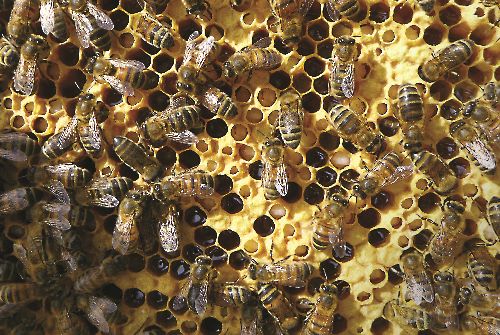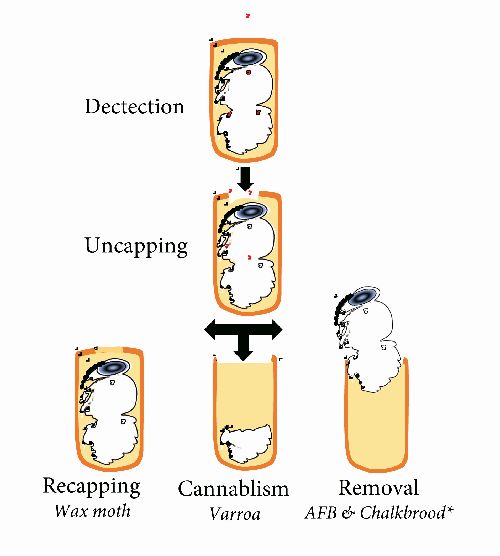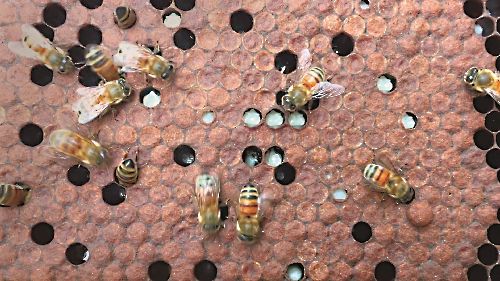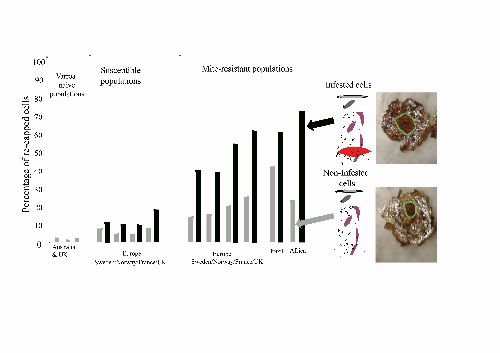Naturally varroa-resistant bees in the UK by Isobel Grindrod and Stephen Martin of the School of Science, Engineering and Environment, University of Salford
 As all beekeepers are aware, Varroa destructor is a major threat to the majority of honey bee colonies. The key problem is that when varroa feeds on the fat body of either the adult or pupa bee it transmits deformed wing virus (DWV), an RNA virus (as is covid-19). The virus shortens the lifespan of adults that are infected as pupae by around two thirds; it also shortens the lifespan of those infected as adults but by a smaller amount. This shortening of the lifespan leads to a loss of workers which can cause the colony to die, typically during the long winter in the UK.
As all beekeepers are aware, Varroa destructor is a major threat to the majority of honey bee colonies. The key problem is that when varroa feeds on the fat body of either the adult or pupa bee it transmits deformed wing virus (DWV), an RNA virus (as is covid-19). The virus shortens the lifespan of adults that are infected as pupae by around two thirds; it also shortens the lifespan of those infected as adults but by a smaller amount. This shortening of the lifespan leads to a loss of workers which can cause the colony to die, typically during the long winter in the UK.
We now know that, in the absence of DWV, varroa-infested colonies can survive indefinitely without requiring treatment as the mites become unable to produce many new offspring, although the mechanism behind this is unknown. Varroa-infested colonies that are free of DWV are very rare; populations have been found on the remote Brazilian island of Fernando de Noronha, Papua New Guinea and the Solomon Islands. However, in all other populations the eradication of DWV is impossible and the solution to the varroa-DWV problem needs to be found elsewhere.
Hygienic behaviour
 Fortuitously, the bees already have an existing behaviour called hygienic behaviour. This is a natural response to disease that is seen in many social insects (bees, ants, wasps) including our bees. Honey bees conduct hygienic behaviour in response to many diseases and pests such as chalkbrood, European foulbrood and wax moth infestation. Hygienic behaviour entails the detection and uncapping of infected cells and the removal of the contents.
Fortuitously, the bees already have an existing behaviour called hygienic behaviour. This is a natural response to disease that is seen in many social insects (bees, ants, wasps) including our bees. Honey bees conduct hygienic behaviour in response to many diseases and pests such as chalkbrood, European foulbrood and wax moth infestation. Hygienic behaviour entails the detection and uncapping of infected cells and the removal of the contents.
[Diagram: Stages of hygienic behaviour showing the different outcomes depending on the disease (Reporduced from the BBKA speical issue on Natural Varroa Resistance.]
The good news is that despite varroa being a novel parasite for Apis mellifera, the bees have already begun using hygienic behaviour to combat this threat. Hygienic behaviour or brood removal has several steps: mite detection, the creation of a hole in the cap and then resealing the cell (recapping) or removing the contents.
Mite detection is thought to occur via an odour coming from within the cell. Creating a hole may allow this smell to be more easily detected or may allow access to a second cue (eg odour) which, if present, could drive the emptying of the cell. Interestingly, each of the steps is thought to be undertaken by a different group of bees. Each group may have differing sensitivities to odour, explaining why errors in uncapping and recapping may occur. For example, non-infested cells are often uncapped perhaps by overly sensitive bees and infested cells are falsely recapped by less sensitive bees. Additionally, each group of bees may differ in numbers within each colony, which may help explain the incidence of bald brood (see photo, right), which can occur when there are more ‘uncapper’ bees than ‘recapper’ bees. Bald brood is when many of the sealed brood have their entire cell caps removed. Typically, the uncapped sealed brood are at the white-eyed to purple-eyed developmental stage and, if left, disappear. We now know that the majority of these uncapped cells are eventually recapped and develop normally. Often beekeepers see bald brood as a bad thing and requeen their colonies, which we are now realising may not be the best thing to do.
Natural varroa resistance
This hygienic behaviour is at the very heart of the evolution of naturally varroa-resistant (NVR) populations. NVR was first detected in populations of Africanised bees as they spread throughout South America. It was their ability to develop varroa resistance that helped them to spread quickly and take over from the susceptible European honey bees. Later, NVR populations appeared in South Africa after a few years of colony losses during which time the more resilient populations adapted quickly to the mite.
 In both Africa and Latin America, chemical varroa-control methods were not commonly used, often because of the cost and the remote location of beekeeping communities. Chemical control halts the development of resistance by removing the selective pressure (the mite) from the bee populations.
In both Africa and Latin America, chemical varroa-control methods were not commonly used, often because of the cost and the remote location of beekeeping communities. Chemical control halts the development of resistance by removing the selective pressure (the mite) from the bee populations.
[Photo: Typical bald brood in a colony with the opened cells containing pupae with white eyes in this case. Some cells in the centre contain half-eaten pupae, probably infested by varroa.]
Don’t suddenly stop treating
However, it is not advisable for beekeepers to suddenly stop using chemical control methods because this would cause the majority, if not all, of their colonies to die. This is because the bees need time alongside the mites to learn how to deal with them, and we know that even NVR colonies can collapse if a large number of mites overwhelm the colony. Diagram 2 How increased detection leads to increases (up arrows) or decreases (down arrows) for each measurable trait Typical bald brood in a colony with the opened cells containing pupae with white eyes in this case. Some cells in the centre contain half-eaten pupae, probably infested by varroa. For NVR to be successfully encouraged, colonies need first to be screened for their potential to be able to control the mite without chemical aid. Additionally, any change in regimen needs to be phased to prevent a sudden massive mite buildup. Hence, if you reduce the number of treatments applied you must increase the amount of monitoring. It is also imperative that you do not allow any of your colonies to collapse and therefore treatment needs to be applied if mite populations begin increasing again.
NVR traits
Despite these problems, there have been increasing reports of varroa-resistant populations across Europe and the UK. All NVR populations appear to have the same traits in common: enhanced mite detection, increased recapping behaviour, increased brood removal and reduced mite reproduction. These traits all connect together and lead to a reduced mite burden, reduced DWV load and enhanced colony survival. Importantly, as these traits are all shared between NVR (resistant) populations it indicates that bees have adopted the same solution for dealing with varroa irrespective of location, type of beekeeping, colour or subspecies of bee. This is great news since you can still keep your favourite type or colour of bee and end up with an NVR population.

[Diagram: How increased detection leads to increases (up arrows) or decreases (down arrows) for each measurable trait.]
The NVR mechanism relies on the bees being more able to detect mite-infested pupae; this is indicated by their increased ability to remove mites. A side effect of the removal behaviour is increased rates of recapping of both infested and non-infested cells. Measuring the recapping rates in a colony is the easiest way to get an indicator of how NVR your colony may be.

[Diagram: A chart comparing the recapping rates across several countries and an indication that all colonies can detect mites since the black bars (infested cells) are higher than grey bars (non-infested cells)].
In the diagram, the recapping rates of infested cells are consistently higher than the recapping rate of non-infested cells, irrespective of the location or whether the bees are susceptible or have NVR characteristics. This indicates that all honey bee colonies have the ability to detect varroa; it’s simply that NVR colonies are much better at doing it. Beekeepers should be looking for recapping rates of greater than 40% for infested cells, but colonies above 30% are well on the way to becoming NVR.
This increased brood removal leads to varroa resistance because brood removal inhibits the reproduction and thus population growth of the mites. This is because, when an infested cell is emptied, all of the mite offspring die. The mother mite does escape because of chemical camouflage, but her limited egg supply is reduced. The mother survives and tries again to reproduce in another cell but, when the rate of removal is high enough, this impediment to reproduction can drastically reduce overall mite reproductive success and subsequent population growth. Over time this can lead to a build-up of infertile mites as they have used up their eggs in failed reproductive attempts. Ultimately the reduced mite population and increased removal means that the DWV load of the colony is also reduced because there are fewer vectors (the mites) to spread the disease and fewer infected pupae (because they are removed).
A combination of a reduced DWV and mite burden results in enhanced survival because there are fewer weakened colony members.
Encouraging NVR
This may all sound too good to be true, but already in the UK there are numerous beekeepers who have been keeping their bees treatment-free, several for more than a decade. The largest area is in North Wales, where over 100 beekeepers have been maintaining around 500 colonies treatmentfree for more than ten years. They started by collecting wild swarms from the surrounding woods where they had observed feral colonies surviving for long periods of time.
We have written a small BBKA Special Issue Series booklet entitled Natural Varroa Resistant Honey Bees: Biology, Testing and Propagation that starts to show how to look for NVR and the science behind it. It has been written for beekeepers in a way that makes the problem and how to test for and propagate NVR easy to understand. It costs £4 and is available from the BBKA shop.
So, despite all the current problems and gloomy outlook for our bees, the future has never been so good. We thank the beekeepers who helped with our research and the funding from the Bee Diseases Insurance and the BBKA without which this research would be impossible.
The underside of two recapped cells shows the contrast between the silky cocoon and matt waxy region where the hole has been resealed. The green line indicates the boundary of the recapped area for clarity.
Images courtesy of Stephen Martin and Richard Rickitt
January 2021
Other articles this month included:
The Healthy Bees Plan 2020 by Rebekah Clarkson
Improved pollination enhancing Ugandan lives by Sylvia Dekker
Queen rearing on the honey farm by Duncan Simmons

Subscribe to BeeCraft Magazine
- £27.00* - Digital Subscription | 12 months
- £45.00* - UK Printed Subscription | 12 months
- £80.00 - UK Printed Subscription | 24 months
* UK residents over the age of 18 can subscribe to BeeCraft via Direct Debit and save up to £7.00 on your subscription. For more information on our Direct Debit scheme, please click here.
- £27.00 - Digital Subscription | 12 months
- £50.00 - Digital Subscription | 24 months
- £67.00 - RoI & European Printed Subscription | 12 months
- £27.00 - Digital Subscription | 12 months
- £50.00 - Digital Subscription | 24 months
- £90.00 - Worldwide Printed Subscription | 12 months


